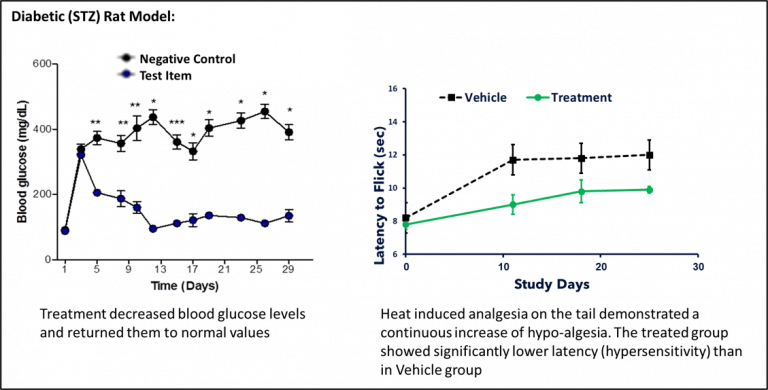Metabolic Disorder Models
Metabolic disorders, such as diabetes and obesity, are increasing health threats in the Western world. The animal models of metabolic diseases, such as hereditary models, chemical or diet induced models, as well as gene-engineered models, made a major contribution in revealing the pathophysiology. These models provide novel insights and lead to the development of new therapies and drugs.
Animal models that have been used at Pharmaseed are:
- Transgenic mice, generally referred to as representing Non-Obese Diabetics (NOD).
- High Fat Diet (HFD) in rodents, mostly representing Diabetes Mellitus (DM) Type 2.
- Chemically-induced Diabetes (Streptozotocine–STZ; Alloxan) – both mostly related to DM Type 1.
- Obesity and diabetes-prone animals, e.g. Sand Rats and ob-ob or db-db mice.
- Diabetic rodents with high blood glucose levels are used in models of several diseases in which diabetes has a major impact:
- Hypertension, affecting large part of diabetic patients, often studied in Spontaneously Hypertensive Rats (SHRs).
- Stroke using the transient or permanent Middle Cerebral Artery Occlusion (MCAO) models.
- Wound healing, heavily impaired by the diabetic condition.
- Erectile Dysfunction, using STZ-induced diabetic rats and monitoring the Intra-Cavernosal Pressure (ICP) and Masson trichrome or IHC histology.
- Impaired blood flow, such as in the mouse Hind Limb Ischemia (HLI) model, a disorder affecting diabetic patients suffering from Peripheral Artery Disease (PAD). The LASER Speckle Contrast Imaging (LSCI) system, as well as histology evaluation, are used to follow blood flow rehabilitation and the angiogenesis following HLI treated mice.
Our services support an array of therapeutic disciplines

Cell & Gene based Therapy

Biological therapy

Cannabis based therapy

Microbiome

Pharmaceuticals

Medical devices

Nutraceuticals
Metabolic Disorder Models
- Models available: DB/DB, ZUCKER-Leprf, STZ, High fat diet.
- Species available: Mouse, Rat.
- Standard assessments: Body weight, clinical signs, blood glucose, food consumption, blood chemistry (including HbA1c, glucose level, acidosis), biochemistry.
- Additional assessments: Kidney function evaluation, histology, glucose tolerance test, ophthalmological evaluation, erectile dysfunction, blood flow (laser speckle), necrosis scoring (ischemia evaluations), wound closure measurement (diabetic wound healing).
- Models available: High fat high sucrose (western diet).
- Species available: Mouse, Rat.
- Standard assessments: Body weight, clinical signs, blood glucose, food consumption, blood chemistry and biochemistry.
- Additional assessments: Histology, Metabolic cages (metabolic assessment).
- Species available: Pig.
- Standard assessments: Body weight, clinical signs, PTH level assessment, blood chemistry and biochemistry.
Research outcomes - examples




